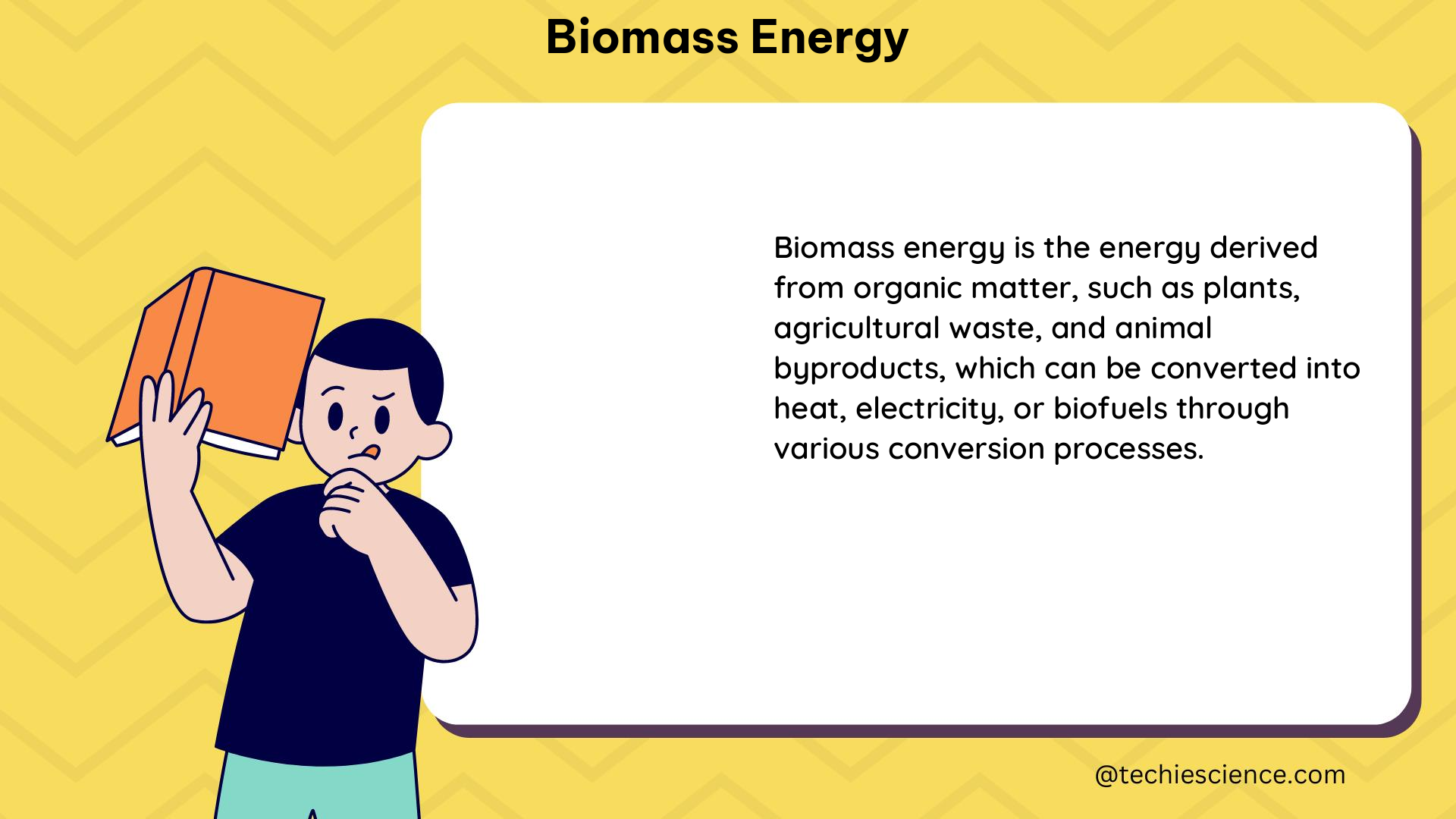Biomass energy is a renewable energy source derived from organic matter such as wood, agricultural crops, and waste materials. It is a versatile and sustainable energy solution that can be harnessed through various conversion technologies, including combustion, gasification, and anaerobic digestion. This comprehensive guide delves into the technical specifications, measurable data, and quantifiable insights that are crucial for understanding and optimizing biomass energy systems.
Technical Specifications of Biomass Energy
Energy Conversion Efficiency
The energy conversion efficiency of biomass energy systems is a crucial metric that determines the overall performance and viability of the technology. The efficiency can be calculated using the following formula:
Energy Conversion Efficiency = (Energy Output / Energy Input) × 100%
Where:
– Energy Output is the amount of useful energy (electricity or heat) generated by the system.
– Energy Input is the amount of energy contained in the biomass feedstock.
The energy conversion efficiency varies depending on the specific technology used. For example, anaerobic digestion can achieve an efficiency of 30-40% for electricity generation and 40-50% for heat generation, while direct combustion systems can reach efficiencies of 20-30% for electricity and 60-80% for heat.
Energy Output
The energy output of biomass conversion systems can be measured in terms of electricity generated (in kWh or MWh) or heat produced (in MJ or GJ). For instance, a biomass power plant with a capacity of 1 MW can generate approximately 8,760 MWh of electricity per year, assuming a capacity factor of 100%.
The energy output is directly influenced by the characteristics of the biomass feedstock, such as its energy content, moisture content, and chemical composition. For example, a feedstock with a higher energy content (e.g., dry wood) will generally produce more energy per unit of mass compared to a feedstock with a lower energy content (e.g., high-moisture agricultural waste).
Feedstock Characteristics
The chemical composition and physical properties of the biomass feedstock are critical factors that affect the energy conversion efficiency and overall performance of the biomass energy system. Key feedstock characteristics include:
- Moisture Content: The moisture content of the biomass can significantly impact the energy conversion efficiency. A feedstock with a moisture content of 20% can reduce the energy output by 10-15% compared to a feedstock with a moisture content of 10%.
- Ash Content: The ash content of the biomass can affect the handling and processing requirements, as well as the potential for fouling and slagging in the conversion system. Typical ash contents range from 0.5% to 15% on a dry basis.
- Calorific Value: The calorific value, or energy content, of the biomass is typically measured in terms of the higher heating value (HHV) or lower heating value (LHV). The HHV can range from 12 to 21 MJ/kg for various biomass feedstocks.
- Elemental Composition: The elemental composition of the biomass, particularly the carbon, hydrogen, oxygen, nitrogen, and sulfur content, can impact the combustion characteristics and emissions profile of the conversion system.
Emissions
Biomass energy production can result in the emission of various pollutants, including carbon dioxide (CO2), carbon monoxide (CO), nitrogen oxides (NOx), and sulfur oxides (SOx). These emissions can be measured in terms of kg of pollutant per MJ of thermal energy produced or per kWh of electricity generated.
The emissions profile of a biomass energy system depends on factors such as the type of feedstock, the conversion technology, and the emission control measures in place. For example, a biomass energy plant with a capacity of 1 MW can emit approximately 0.04584 kg CO2 eq/MJ of thermal energy produced.
It is important to note that the net emissions from biomass energy can be considered carbon-neutral, as the carbon dioxide released during the conversion process is balanced by the carbon dioxide absorbed by the biomass during its growth. However, the overall environmental impact of biomass energy production should also consider factors such as land use, water consumption, and the sustainability of the biomass supply chain.
Measurable Data for Biomass Energy Systems

Energy Consumption
The energy consumption of biomass energy plants can be measured in terms of the electricity (in kWh) or thermal energy (in MJ) required to operate the system. For instance, a biomass energy plant with a capacity of 1 MW can consume approximately 1,000 kWh of electricity per hour to power the various components, such as feedstock handling, conversion, and emission control systems.
The energy consumption of a biomass energy system is influenced by factors such as the size and complexity of the plant, the type of conversion technology, and the degree of automation and optimization in the system design.
Water Consumption
The water consumption of biomass energy plants can be measured in terms of liters per hour or cubic meters per day. This metric is particularly important in regions with limited water resources or where water scarcity is a concern.
For example, a biomass energy plant with a capacity of 1 MW can consume approximately 100 liters of water per hour for various purposes, such as cooling, steam generation, and ash handling. The water consumption can vary depending on the specific technology used, the cooling system employed, and the water recycling and treatment measures implemented.
Ash Production
The ash production of biomass energy plants can be measured in terms of kilograms of ash produced per hour or per day. Ash is a byproduct of the biomass conversion process and can consist of inorganic materials such as minerals and unburned carbon.
For instance, a biomass energy plant with a capacity of 1 MW can produce approximately 100 kg of ash per hour. The ash production rate is influenced by factors such as the ash content of the biomass feedstock, the conversion technology used, and the efficiency of the combustion or gasification process.
The management and disposal of the ash produced by biomass energy plants is an important consideration, as it can have environmental implications and may require specialized handling and treatment.
Quantifiable Data for Biomass Energy Systems
Carbon Sequestration
Biomass energy production can contribute to the sequestration of carbon dioxide (CO2) from the atmosphere, as the biomass feedstock absorbs CO2 during its growth. This carbon sequestration potential can be quantified in terms of the amount of CO2 (in tons) that can be removed from the atmosphere per year.
For example, a biomass energy plant with a capacity of 1 MW can sequester approximately 10,000 tons of CO2 per year, assuming the biomass feedstock is sustainably sourced and the net emissions from the conversion process are negligible or offset by the carbon absorption during growth.
Land Use
The land use requirements for biomass energy production can be measured in terms of hectares of land required per MW of installed capacity. This metric is important for understanding the spatial footprint and potential land-use conflicts associated with biomass energy projects.
A biomass energy plant with a capacity of 1 MW can require approximately 100 hectares of land, depending on factors such as the type of biomass feedstock, the conversion technology, and the availability of suitable land for cultivation or collection.
Job Creation
The job creation potential of biomass energy production can be quantified in terms of the number of jobs created per MW of installed capacity. This metric is relevant for understanding the economic and social impacts of biomass energy projects, particularly in rural or agricultural communities.
A biomass energy plant with a capacity of 1 MW can create approximately 10 jobs, including positions in feedstock production, plant operation, maintenance, and support services. The job creation potential can vary depending on the specific technology, the scale of the project, and the local economic and labor market conditions.
References
- ACEEE. (n.d.). Background Best Practices in Energy Management Goals. Retrieved from https://www.aceee.org/files/pdf/toolkit/energy-usage-intensity.pdf
- European Space Agency. (n.d.). Biomass Objectives. Retrieved from https://earth.esa.int/eogateway/missions/biomass/objectives
- NCBI. (2019). Assessment of environmental impact of biomass power plants to support decision-making. Retrieved from https://www.ncbi.nlm.nih.gov/pmc/articles/PMC6630023/
- NREL. (n.d.). Biomass Compositional Analysis Laboratory Procedures. Retrieved from https://www.nrel.gov/bioenergy/biomass-compositional-analysis.html
- LinkedIn. (2024). How to Measure Energy Output in Biomass Conversion. Retrieved from https://www.linkedin.com/advice/1/what-most-accurate-way-measure-energy-output-biomass-hlguf

I am Subrata, Ph.D. in Engineering, more specifically interested in Nuclear and Energy science related domains. I have multi-domain experience starting from Service Engineer for electronics drives and micro-controller to specialized R&D work. I have worked on various projects, including nuclear fission, fusion to solar photovoltaics, heater design, and other projects. I have a keen interest in the science domain, energy, electronics and instrumentation, and industrial automation, primarily because of the wide range of stimulating problems inherited to this field, and every day it’s changing with industrial demand. Our aim here is to exemplify these unconventional, complex science subjects in an easy and understandable to the point manner.